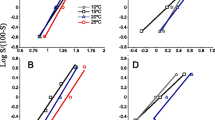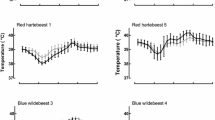Summary
Lamnid sharks are known to have warm red muscle and warm brains. We describe a large vein in lamnid sharks that provides a route for transfer of warm blood from the red muscle to the central nervous system. This ‘red muscle vein’ runs longitudinally in the red muscle and is valved to direct blood flow anteriorly. It joins the myelonal vein in the neural canal, thus providing a route for blood flow from the red muscle to the brain. Temperature profiles along the neural canal of freshly caught mako sharks show that warm blood enters the myelonal vein from the red muscle vein. Experiments with heat generation by model brains indicate that the metabolic heat produced by the brain is probably not sufficient to cause the temperature elevations observed. Metabolic heat imported from the red swimming muscle may be a valuable addition to the heat budget of the head.
Similar content being viewed by others
References
Altman PL, Dittmer DS (1968) Biological handbooks: metabolism. Bethesda, MD: Federation of American Societies for Experimental Biology, pp 385–397
Baker MA (1982) Brain cooling in endotherms in heat and exercise. Annu Rev Physiol 44:85–96
Bakken GS, Buttemer WA, Dawson WR, Gates DM (1981) Heated taxidermic mounts: a means of measuring the standard operative temperature affecting small animals. Ecology 62:311–318
Block BA, Carey FG (1986) Warm brains in lamnid sharks. J Comp Physiol B 156:229–236
Burne RH (1923) Some peculiarities of the blood vascular system of the porbeagle shark,Lamna cornubica. Phil Trans R Soc Lond Ser B: 212:209–257
Carey FG (1982) A brain heater in the swordfish. Science 216:1327–1329
Carey FG, Casey JG, Pratt HL, Urquhart D, McCosker JE (1985) Temperature, heat production and heat exchange in lamnid sharks. Mem South Calif Acad Sci 9:92–108
Carey FG, Gibson QH (1983) Heat and oxygen exchange in the rete mirabile of the bluefin tuna,Thunnus thynnus. Comp Biochem Physiol 74A:333–342
Carey FG, Teal JM (1969) Mako and porbeagle: warm bodied sharks. Comp Biochem Physiol 28:199–204
Carey FG, Teal JM, Kanwisher JW (1981) The visceral temperatures of mackerel sharks (Lamnidae). Physiol Zool 54:334–344
Frost PGH, Siegfried WR, Greenwood PJ (1975) Arterio-venous heat exchange systems in the Jackass penguinSpheniscus demersus. J Zool (Lond) 175:231–241
Gooding RM, Neill WH, Dizon AE (1981) Respiration rates and low oxygen tolerance in skipjack tuna,Katsuwonnus pelamis. Fish Bull US 79:31–48
Hodgman CD (1954) Handbook of chemistry and physics. Chemical Rubber Publishing Co. Cleveland, Ohio
Kilgore DL, Bernstein MH, Hudson DM (1976) Brain temperatures in birds. J Comp Physiol 110:209–215
Linthicum DS, Carey FG (1972) Regulation of brain and eye temperatures by the bluefin tuna. Comp Biochem Physiol 43A:425–433
Müller J (1841) Vergleichende Anatomie der Myxinoiden. Abh Königl Akad Wiss Berlin aus d Jahre 1839:175–303
Northcutt RG (1978) Brain organization in cartilaginous fishes. In: Hodgson ES, Mathewson RF (eds) Sensory biology of sharks, skates and rays. US Navy Office of Naval Research, Arlington, VA, pp 117–193
Raichle ME, Grubb RL, Eichling JO, Ter-Pogossian MM (1976) Measurement of brain oxygen utilization with radioactive oxygen-15: Experimental verification. J Appl Physiol 40:638–640
Rhodes D, Smith R (1983) Body temperature of the salmon shark,Lamna ditropis. J Mar Biol Ass UK 63:243–244
Stevens ED, Fry FEJ (1971) Brain and muscle temperatures in ocean caught and captive skipjack tuna. Comp Biochem Physiol 38A:203–211
Taylor CR, Lyman CP (1972) Heat storage in running antelopes: Independence of brain and body temperatures. Am J Physiol 222:114–117
Thorkelson J, Maxwell RK (1974) Design and testing of a heat transfer model of a raccoon (Procyon lotor) in a closed tree den. Ecology 55:29–39
Author information
Authors and Affiliations
Rights and permissions
About this article
Cite this article
Wolf, N.G., Swift, P.R. & Carey, F.G. Swimming muscle helps warm the brain of lamnid sharks. J Comp Physiol B 157, 709–715 (1988). https://doi.org/10.1007/BF00691001
Accepted:
Issue Date:
DOI: https://doi.org/10.1007/BF00691001




